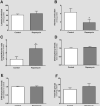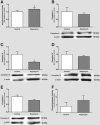Mammalian target of rapamycin controls glucose consumption and redox balance in human Sertoli cells
- PMID: 26698679
- PMCID: PMC4845725
- DOI: 10.1016/j.fertnstert.2015.11.032
Mammalian target of rapamycin controls glucose consumption and redox balance in human Sertoli cells
Abstract
Objective: To study the role of mammalian target of rapamycin (mTOR) in the regulation of human Sertoli cell (hSC) metabolism, mitochondrial activity, and oxidative stress.
Design: Experimental study.
Setting: University research center and private assisted reproductive technology centers.
Patient(s): Six men with anejaculation (psychological, vascular, neurologic) and conserved spermatogenesis.
Intervention(s): Testicular biopsies were used from patients under treatment for recovery of male gametes. Primary hSCs cultures were established from each biopsy and divided into a control group and one treated with rapamycin, the inhibitor of mTOR, for 24 hours.
Main outcome measure(s): Cytotoxicity of hSCs to rapamycin was evaluated by sulforhodamine B assay. The glycolytic profile of hSCs was assessed by proton nuclear magnetic resonance and by studying protein expression of key glycolysis-related transporters and enzymes. Expression of mitochondrial complexes and citrate synthase activity were determined. Protein carbonylation, nitration, lipid peroxidation, and sulfhydryl protein group contents were quantified. The mTOR signaling pathway was studied.
Result(s): Rapamycin increased glucose consumption by hSCs, maintaining lactate production. Alanine production by rapamycin-exposed hSCs was affected, resulting in an unbalanced intracellular redox state. Rapamycin-exposed hSCs had decreased expression of mitochondrial complex III and increased lipid peroxidation, whereas other oxidative stress markers were unaltered. Treatment of hSCs with rapamycin down-regulated phospho-mTOR (Ser-2448) levels, illustrating an effective partial inhibition of mTORC1. Protein levels of downstream signaling molecule p-4E-BP1 were not altered, suggesting that during treatment it became rephosphorylated.
Conclusion(s): We show that mTOR regulates the nutritional support of spermatogenesis by hSCs and redox balance in these cells.
Keywords: Sertoli cells; mTOR; rapamycin; spermatogenesis; testis.
Copyright © 2016 American Society for Reproductive Medicine. Published by Elsevier Inc. All rights reserved.
Figures




Similar articles
-
Metabolic dynamics of human Sertoli cells are differentially modulated by physiological and pharmacological concentrations of GLP-1.Toxicol Appl Pharmacol. 2019 Jan 1;362:1-8. doi: 10.1016/j.taap.2018.10.009. Epub 2018 Oct 6. Toxicol Appl Pharmacol. 2019. PMID: 30296456
-
Ghrelin acts as energy status sensor of male reproduction by modulating Sertoli cells glycolytic metabolism and mitochondrial bioenergetics.Mol Cell Endocrinol. 2016 Oct 15;434:199-209. doi: 10.1016/j.mce.2016.07.008. Epub 2016 Jul 5. Mol Cell Endocrinol. 2016. PMID: 27392494
-
Melatonin alters the glycolytic profile of Sertoli cells: implications for male fertility.Mol Hum Reprod. 2014 Nov;20(11):1067-76. doi: 10.1093/molehr/gau080. Epub 2014 Sep 9. Mol Hum Reprod. 2014. PMID: 25205674
-
New inhibitors of the PI3K-Akt-mTOR pathway: insights into mTOR signaling from a new generation of Tor Kinase Domain Inhibitors (TORKinibs).Curr Top Microbiol Immunol. 2010;347:241-62. doi: 10.1007/82_2010_64. Curr Top Microbiol Immunol. 2010. PMID: 20549474 Review.
-
Role of the mammalian target of rapamycin pathway in lentiviral vector transduction of hematopoietic stem cells.Curr Opin Hematol. 2015 Jul;22(4):302-8. doi: 10.1097/MOH.0000000000000150. Curr Opin Hematol. 2015. PMID: 26049750 Free PMC article. Review.
Cited by
-
Autophagy Induced by ROS Aggravates Testis Oxidative Damage in Diabetes via Breaking the Feedforward Loop Linking p62 and Nrf2.Oxid Med Cell Longev. 2020 May 18;2020:7156579. doi: 10.1155/2020/7156579. eCollection 2020. Oxid Med Cell Longev. 2020. PMID: 32509151 Free PMC article. Review.
-
mTOR Regulates Gap Junction Alpha-1 Protein Trafficking in Sertoli Cells and Is Required for the Maintenance of Spermatogenesis in Mice.Biol Reprod. 2016 Jul;95(1):13. doi: 10.1095/biolreprod.115.138016. Epub 2016 Jun 8. Biol Reprod. 2016. PMID: 27281705 Free PMC article.
-
A Human Gonadal Cell Model From Induced Pluripotent Stem Cells.Front Genet. 2018 Oct 24;9:498. doi: 10.3389/fgene.2018.00498. eCollection 2018. Front Genet. 2018. PMID: 30405703 Free PMC article.
-
In Vitro and In Vivo Models for Drug Transport Across the Blood-Testis Barrier.Drug Metab Dispos. 2023 Sep;51(9):1157-1168. doi: 10.1124/dmd.123.001288. Epub 2023 May 31. Drug Metab Dispos. 2023. PMID: 37258305 Free PMC article. Review.
-
Mammalian target of rapamycin (mTOR): a central regulator of male fertility?Crit Rev Biochem Mol Biol. 2017 Jun;52(3):235-253. doi: 10.1080/10409238.2017.1279120. Epub 2017 Jan 26. Crit Rev Biochem Mol Biol. 2017. PMID: 28124577 Free PMC article. Review.
References
-
- Mruk DD, Cheng CY. Sertoli-Sertoli and Sertoli-germ cell interactions and their significance in germ cell movement in the seminiferous epithelium during spermatogenesis. Endocrinol Rev. 2004;25:747–806. - PubMed
-
- Rato L, Socorro S, Cavaco JE, Oliveira PF. Tubular fluid secretion in the seminiferous epithelium: ion transporters and aquaporins in Sertoli cells. J Membr Biol. 2010;236:215–24. - PubMed
-
- Griswold MD. The central role of Sertoli cells in spermatogenesis. Semin Cell Dev Biol. 1998;9:411–6. - PubMed
Publication types
MeSH terms
Substances
Grants and funding
LinkOut - more resources
Full Text Sources
Other Literature Sources
Molecular Biology Databases
Miscellaneous

